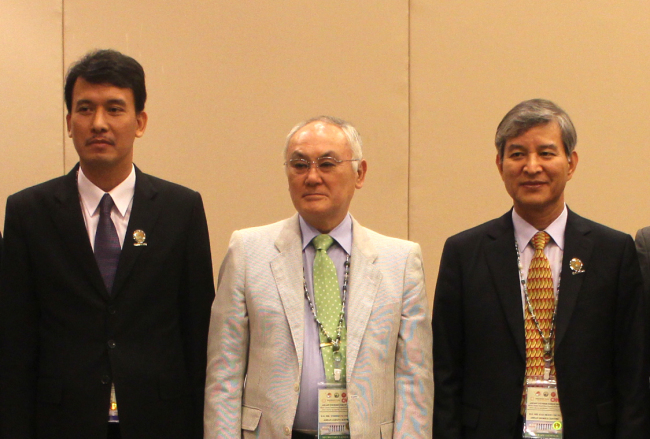The heads of ASEAN centers in Korea, China and Japan held a meeting in Naypyidaw, Myanmar, on Sunday to increase cooperation across the agencies to better accommodate the Southeast Asian nations.
The meeting was attended by Secretary-General of ASEAN-Korea Center Chung Hae-moon, Secretary-General of ASEAN-Japan Center Yoshikuni Ohnishi and ASEAN-China Center director of education, culture and tourism division Purnajaya Tri. They discussed ways to boost staff exchanges, information sharing and publications.
The ASEAN Economic Community, slated to launch at the end of this year, will create a single regional common market of 640 million people with a combined gross domestic product of $3 trillion. There will be free flow of goods, services, investment capital and skilled labor following the liberalization.
 |
Chung Hae-moon (right), secretary-general of ASEAN-Korea Center, poses with Yoshikuni Ohnishi (center), secretary-general of ASEAN-Japan Center, and Purnajaya Tri, ASEAN-China Center director of education, culture and tourism division, during their meeting in Naypyidaw, Myanmar, Sunday. (ASEAN-Korea Center) |
“The AEC will accelerate East Asia’s integration and work as a growth engine for the global economy,” Chung told The Korea Herald in an email. “ASEAN and Korea together will usher in a new era of cooperation ― as partners for regional peace, prosperity and multiculturalism.”
The trilateral meeting, in its fifth running, aims to work within the “ASEAN Plus Three Cooperation” framework that includes Korea, China and Japan. The ASEAN Plus Three summit was held in Naypyidaw last year.
An ASEAN-Korea Center official said that the meeting would serve as a foundation for exchanging best practices and know-how for possible joint projects. “Each country has developed its own expertise and knowledge, therefore we expect synergy by working together and collectively engaging with our ASEAN partners,” he added.
ASEAN and Korea have developed relations since 1989. In 2013, ASEAN was Korea’s top tourism destination, second-largest trade partner and third-largest investment destination. Korean firms have participated in an increasing number of construction and infrastructure development projects in a regionwide effort to facilitate connectivity.
Bilateral trade volume is expected to reach $200 billion by 2020, bolstered by the ASEAN-Korea free trade agreement and the regional comprehensive economic partnership currently under negotiation ― which includes ASEAN, Korea, China, Japan, India, Australia and New Zealand.
In the run-up to the launch of AEC on Dec. 31 this year, the ASEAN-Korea Center will host cultural events, investment and trade seminars, youth networking venues, interagency consultations, vocational training and joint research projects.
By Joel Lee (
joel@heraldcorp.com)








